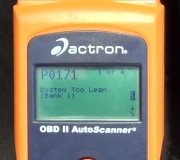Check for vacuum leak
suspect MAF sensor
. On a fully warmed up engine, look at MAF voltage at idle, in Neutral, A/C off (MAF V PID). If it's 30% greater than the nominal MAF V voltage listed in the Powertrain Control/Emissions Diagnosis (PC/ED) Diagnostic Value Reference Charts for your vehicle, or greater than 1.1 volts as a rough guide, the MAF sensor is over-estimating air flow at idle.
If at least two of the previous three steps are true, proceed to disconnect the MAF sensor connector. This puts the vehicle into Failure Mode and Effects Management (FMEM). In FMEM mode, air flow is inferred by using rpm and throttle position instead of reading the MAF sensor. (In addition, the BARO value is reset to a base/unlearned value.) If the lean driveability symptoms go away, the MAF sensor is probably contaminated and should be replaced. If the lean driveability symptoms do not go away, go to the PC/ED Service Manual for the appropriate diagnostics.
NOTE: Due to increasingly stringent emission/OBDII requirements, it is possible for some vehicles with MAF sensor contamination to set fuel system DTCs and illuminate the MIL with no driveability concerns. Disconnecting the MAF on these vehicles will, therefore, produce no improvements in driveability. In these cases, if the BARO, LONGFT1, LONGFT2, and MAF V PIDs indicate that the maf is contaminated, proceed to replace the MAF sensor.
After replacing the MAF sensor, disconnect the vehicle battery (5 minutes, minimum) to reset KAM, or on newer vehicles, use the "KAM Reset" feature on the New Generation Star (NGS) Tester and verify that the lean driveability symptoms are gone.
Monday, February 23rd, 2009 AT 7:32 PM



